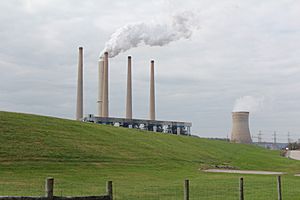J.M. Stuart Station facts for kids
Quick facts for kids J.M. Stuart Station |
|
|---|---|

J.M. Stuart Station in 2017 viewed from U.S. Route 52
|
|
| Country | United States |
| Location | Sprigg Township, Adams County, near Aberdeen, Ohio |
| Coordinates | 38°38′16″N 83°41′35″W / 38.63778°N 83.69306°W |
| Status | Decommissioned |
| Commission date | Unit 1: 1971 Unit 2: 1970 Unit 3: 1972 Unit 4: 1974 |
| Decommission date | Unit 1: 2017 Units 2–4: May 24, 2018 |
| Owner(s) | AES Ohio Generation (35%) AEP Generation Resources (26%)< Dynegy (39%) |
| Operator(s) | AES Ohio Generation |
J.M. Stuart Station was a very large power plant that used coal to make electricity. It was located in Adams County, Ohio, near a town called Aberdeen, Ohio. This plant had four big units that worked together to create power. It was run by a company called AES Ohio Generation. The J.M. Stuart Station started making electricity in 1970 and stopped on May 24, 2018. It could produce 2,318 megawatts of power, which is enough for many homes!
Contents
How the J.M. Stuart Power Plant Was Built
Building the J.M. Stuart Station began in 1966. The plant opened its first units, Unit 2, Unit 1, and Unit 3, in 1970, 1971, and 1972. The entire plant was fully working when Unit 4 was finished in 1974. The total cost to build this huge power plant was about $390 million.
The plant was named after James M. Stuart. He used to be in charge of a company called Dayton Power & Light (DP&L). The plant used water from the Ohio River to help cool its systems. In the 1980s, the Stuart plant started using a special machine called a prompt gamma neutron activation analysis (PGNAA) to check the coal. This machine helped the plant work better and more reliably.
In 2014, a company called Duke Energy sold its part of the plant to Dynegy. Another company, American Electric Power (AEP), also owned a share of the plant. In 2017, the company running the plant changed from DP&L to AES Ohio Generation.
Why the Plant Closed Down
In March 2017, DP&L announced that it would close the J.M. Stuart Station. They also decided to close another plant called Killen Station. These plants were closed because of money problems and environmental concerns. The decision was made with an agreement involving the Sierra Club, a group that works to protect the environment. The J.M. Stuart Station stopped making electricity on May 24, 2018. In 2019, the land where the plant stood was sold to a company called Kingfisher Development. This company plans to clean up the site and use the land for new projects.
Protecting the Environment
When Unit 4 was being built, a cooling tower was added. This was done to follow rules set by the State of Ohio to control pollution. The plant's four tall smokestacks were also updated with special filters called electrostatic precipitators. These filters helped stop fly ash (tiny bits of burned coal) from going into the air.
The Stuart plant was also a test site for a new technology called the Low-NO
x Cell Burner (LNCB). This project tested how well the LNCB could reduce harmful gases. The tests showed that it could cut down on nitrogen oxide (NO
x ) emissions by more than half!
Between 2003 and 2004, each unit at the plant got new systems called selective catalytic reduction (SCR). These SCR systems were installed to follow the Clean Air Act amendments from 1990. This law helps keep our air clean.
In 2008, special equipment called Flue-gas desulfurization (FGD) was added to the J.M. Stuart plant. This equipment was very good at reducing sulfur dioxide (SO
2) emissions. It cut down 97% of the plant's sulfur dioxide pollution! To help with this process, a very tall smokestack, about 900 feet (274 meters) high, was built.
Ancient History at the Plant Site
The land where the J.M. Stuart plant was built, known as the Greenlee Tract, has a long history. Native Americans used this land for over 8,000 years! Later, settlers lived there in the 1800s.
In the 1990s, the power company wanted to expand the areas where they disposed of fly ash. Before they did this, they paid for a study to find out about any important archaeological sites on the Greenlee Tract. Archaeologists studied the land from 1991 to 2011. They found more than 200,000 artifacts! These items showed that people lived and worked on this land from the Pre-Columbian era (before Christopher Columbus arrived) and also in the early 1800s.

